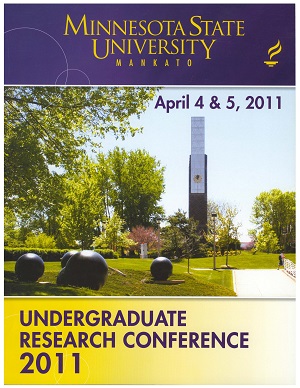Coelomocyte Control of Bacteria Population by Phagocytosis in Eisenia fetida
Location
CSU 253/4/5
Start Date
4-4-2011 11:00 AM
End Date
4-4-2011 12:30 PM
Student's Major
Biological Sciences
Student's College
Science, Engineering and Technology
Mentor's Name
Dorothy Wrigley
Mentor's Department
Biological Sciences
Mentor's College
Science, Engineering and Technology
Description
Earthworm immunity is characterized by coelomocytes, leukocytes housed in the coelomic cavity of earthworms. Coelomic cells are a mixed population that phagocytize and detoxify chemicals. Earthworms also have several symbitotic bacteria that are passed from parent to offspring eggs. The population size of the symbionts must be controlled or they would kill the earthworm. My hypothesis is that coelomic cells aid control of bacterial number by phagocytosis. To test this hypothesis coelomic cells binding of a symbiont from earthworm cocoons was examined. The symbiont used was identified as a Citrobacter. Coelomic cells were collected from earthworms, Eisenia fetida. Coelomic cells were mixed with freshly cultured symbionts, and examined for their ability to bind the symbionts. Binding was assessed at 30 minutes and at 60 minutes using a gram stain method. In Phosphate Buffered Saline (PBS) 80% of the coelomic cells bound the symbionts. The greatest adherence was after 30 minute incubation. When glucose was added to PBS the cells binding bacteria decreased to 20%. Other sugars, galactose and mannose, had no affect on adherence. The data indicates that coelomic cells recognize and bind to the symbiont, and adherence is mediated by sugar binding. Two populations of coelomic cells exist. One population adheres rapidly to glass. When this rapid adhering coelomic cell population was excluded from the cell/symbiont suspension adherence increased to 93%. Further research is being conducted to examine coelomic cell adherence with live versus dead bacteria.
Coelomocyte Control of Bacteria Population by Phagocytosis in Eisenia fetida
CSU 253/4/5
Earthworm immunity is characterized by coelomocytes, leukocytes housed in the coelomic cavity of earthworms. Coelomic cells are a mixed population that phagocytize and detoxify chemicals. Earthworms also have several symbitotic bacteria that are passed from parent to offspring eggs. The population size of the symbionts must be controlled or they would kill the earthworm. My hypothesis is that coelomic cells aid control of bacterial number by phagocytosis. To test this hypothesis coelomic cells binding of a symbiont from earthworm cocoons was examined. The symbiont used was identified as a Citrobacter. Coelomic cells were collected from earthworms, Eisenia fetida. Coelomic cells were mixed with freshly cultured symbionts, and examined for their ability to bind the symbionts. Binding was assessed at 30 minutes and at 60 minutes using a gram stain method. In Phosphate Buffered Saline (PBS) 80% of the coelomic cells bound the symbionts. The greatest adherence was after 30 minute incubation. When glucose was added to PBS the cells binding bacteria decreased to 20%. Other sugars, galactose and mannose, had no affect on adherence. The data indicates that coelomic cells recognize and bind to the symbiont, and adherence is mediated by sugar binding. Two populations of coelomic cells exist. One population adheres rapidly to glass. When this rapid adhering coelomic cell population was excluded from the cell/symbiont suspension adherence increased to 93%. Further research is being conducted to examine coelomic cell adherence with live versus dead bacteria.
Recommended Citation
Novak, Anna B.. "Coelomocyte Control of Bacteria Population by Phagocytosis in Eisenia fetida." Undergraduate Research Symposium, Mankato, MN, April 4, 2011.
https://cornerstone.lib.mnsu.edu/urs/2011/poster-session-B/6



